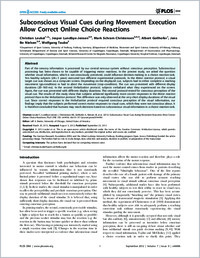Subconscious visual cues during movement execution allow correct online choice reactions
- Leukel, Christian Department of Sport Science, University of Freiburg, Germany - Department of Medicine, Movement and Sport Science, University of Fribourg, Switzerland
- Lundbye-Jensen, Jesper Department of Exercise and Sport Sciences, University of Copenhagen, Denmark - Department of Neuroscience and Pharmacology, University of Copenhagen, Denmark
- Christensen, Mark Schram Department of Exercise and Sport Sciences, University of Copenhagen, Denmark - Department of Neuroscience and Pharmacology, University of Copenhagen, Denmark - Danish Research Centre for Magnetic Resonance, Copenhagen University Hospital Hvidovre, Denmark
- Gollhofer, Albert Department of Sport Science, University of Freiburg, Germany
- Nielsen, Jens Bo Department of Exercise and Sport Sciences, University of Copenhagen, Denmark - Department of Neuroscience and Pharmacology, University of Copenhagen, Denmark
- Taube, Wolfgang Department of Medicine, Movement and Sport Science, University of Fribourg, Switzerland
-
25.09.2012
Published in:
- PLoS ONE. - 2012, vol. 7, no. 9, p. e44496
English
Part of the sensory information is processed by our central nervous system without conscious perception. Subconscious processing has been shown to be capable of triggering motor reactions. In the present study, we asked the question whether visual information, which is not consciously perceived, could influence decision-making in a choice reaction task. Ten healthy subjects (28±5 years) executed two different experimental protocols. In the Motor reaction protocol, a visual target cue was shown on a computer screen. Depending on the displayed cue, subjects had to either complete a reaching movement (go-condition) or had to abort the movement (stop-condition). The cue was presented with different display durations (20–160 ms). In the second Verbalization protocol, subjects verbalized what they experienced on the screen. Again, the cue was presented with different display durations. This second protocol tested for conscious perception of the visual cue. The results of this study show that subjects achieved significantly more correct responses in the Motor reaction protocol than in the Verbalization protocol. This difference was only observed at the very short display durations of the visual cue. Since correct responses in the Verbalization protocol required conscious perception of the visual information, our findings imply that the subjects performed correct motor responses to visual cues, which they were not conscious about. It is therefore concluded that humans may reach decisions based on subconscious visual information in a choice reaction task.
- Faculty
- Faculté des sciences et de médecine
- Department
- Département de Médecine
- Language
-
- English
- Classification
- Biological sciences
- License
- License undefined
- Identifiers
-
- RERO DOC 30516
- DOI 10.1371/journal.pone.0044496
- Persistent URL
- https://folia.unifr.ch/unifr/documents/302583
Statistics
Document views: 87
File downloads:
- tau_svc.pdf: 93
